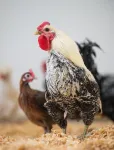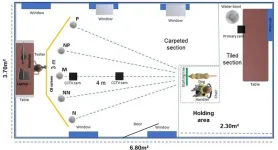(Press-News.org) An international team of researchers led by Professor Huaijun Zhou from the UC Davis Department of Animal Science has created the first-ever detailed map of how genes are regulated in chickens — a breakthrough that could help scientists breed birds that are more resistant to diseases like avian influenza.
The study, published April 8 in Nature Genetics, brings together a massive amount of genetic and epigenetic data of more than 100 chicken breeds from around the world. The team, which included scientists at Aarhus University in Denmark, China Agricultural University and elsewhere, analyzed samples from 28 different chicken tissues to build a comprehensive atlas of gene activity.
“This is the most complete picture we’ve ever had of how genes work in chickens,” said Zhou. “It’s a huge step forward for both basic biology and practical breeding.”
This atlas reveals how millions of genetic variants affect the way genes are regulated, both in terms of gene expression and how RNA is processed, giving researchers critical tools to better understand agriculturally important traits like growth, reproduction and immune response.
The research comes at a crucial time as the United States continues to battle a widespread outbreak of bird flu, a strain of H5N1 influenza that has affected more than 100 million birds and spread to dairy cow herds.
Identifying natural resistance to infection
This new genetic knowledge could help identify birds that are naturally more resistant to infection. That could lead to healthier flocks, more resilient farming systems and fewer economic losses for poultry producers.
“This work highlights how advanced genetics can support animal health and food security,” said Zhou, who was recently recognized with the National Academy of Sciences Prize in Food and Agriculture Sciences for his contributions to poultry genomics.
The project is part of the international FarmGTEx initiative, which is building similar genetic resources for livestock species around the world.
Dailu Guan and Ying Wang from the Department of Animal Science contributed to the research as did scientists from Iowa State University, the University of Maryland, University of Missouri, the U.S. Department of Agriculture’s Agricultural Research Service, Baker Heart and Diabetes Institute, Beijing Institute of Genomics, Centre for AgriBiosciences, Chinese Academy of Agricultural Sciences, Guangdong Academy of Agricultural Sciences, Hunan Agricultural University, L’Institut Agro, Ludwig Maximilian University, McGill University, Nanjing Agricultural University, Université Paris-Saclay, Queen Mary University of London, Scotland’s Rural College, South China Agricultural University, University of Chinese Academy of Sciences, University of Edinburgh, University of Melbourne, University of Oxford, Westlake University.
The research was supported by funding from the USDA’s National Institute of Food and Agriculture and Agricultural Research Service, California Agricultural Experiment Station, Chinese Academies of Science, National Key Research and Development Program of China, National Natural Science Foundation of China, Jiangsu Agricultural Industry Technology System, Science and Technology Planning Project of Guangzhou City and the Local Innovative and Research Teams Project of Guangdong Province.
END
Map of genetic regulation in chickens could help fight against bird flu
2025-04-09
ELSE PRESS RELEASES FROM THIS DATE:
Scientists map unprecedented detail of connections and visual perception in the mouse brain
2025-04-09
What: In a massive scientific effort funded by the National Institutes of Health (NIH), hundreds of researchers have helped to map the connections between hundreds of thousands of neurons in the mouse brain and then overlayed their firing patterns in response to visual stimuli. This breakthrough is a critical piece of foundational science to build toward understanding how our brains process visual information to reconstruct the images we see every day.
Information processing in the human brain occurs ...
Mapping mercury contamination in penguins of the Southern Ocean
2025-04-09
In 1962, when environmentalist and author Rachel Carson penned Silent Spring, alerting the world to the dangers of the pesticide DDT, it was the reproductive threat to birds – the bald eagle in particular – that spurred people to action.
Six decades later, Rutgers University–New Brunswick researchers are taking the measure of another global environmental pollutant by drawing parallels to the crisis Carson identified. This time, the pollutant is mercury, and the sentinels are penguins living in the farthest reaches of the Antarctic Peninsula.
“With mercury, there’s an analogy to DDT,” said John Reinfelder, a professor in the Department of Environmental Sciences ...
Engineer aims to make giant leap for welding materials on the moon
2025-04-09
Before humans can colonize the moon or Mars, scientists and engineers must first develop techniques for building permanent structures and pressurized habitats in harsh, thin-atmosphere and low-gravity environments.
Dr. Wei Li, an assistant professor of mechanical engineering in the Erik Jonsson School of Engineering and Computer Science at The University of Texas at Dallas, is developing a virtual lunar welding platform to troubleshoot assembling large structures in such conditions.
“As we try to return to the ...
Tracking firearm violence and impact on dental health
2025-04-09
Higher firearm violence in neighborhoods is linked to lower rates of people going to the dentist and higher rates of total tooth loss, known as edentulism, according to Rutgers researchers.
Their study, published in the American Journal of Preventive Medicine, used data from the Centers for Disease Control and Prevention for dental care utilization and complete loss of teeth and data from the American Violence Project for firearm violence incidents. The researchers examined 20,332 census tracts within the 100 largest cities in the United States from 2014 to ...
3D streaming gets leaner by seeing only what matters
2025-04-09
A new approach to streaming technology may significantly improve how users experience virtual reality and augmented reality environments, according to a study from NYU Tandon School of Engineering.
The research — presented in a paper at the 16th ACM Multimedia Systems Conference on April 1, 2025 — describes a method for directly predicting visible content in immersive 3D environments, potentially reducing bandwidth requirements by up to 7-fold while maintaining visual quality.
The technology is being applied in an ongoing NYU Tandon National Science Foundation-funded project to bring point cloud video to dance education, making ...
How does heavy drinking affect the brain?
2025-04-09
EMBARGOED FOR RELEASE UNTIL 4:00 P.M. ET, WEDNESDAY, APRIL 9, 2025
MINNEAPOLIS — Heavy drinkers who have eight or more alcoholic drinks per week have an increased risk of brain lesions called hyaline arteriolosclerosis, signs of brain injury that are associated with memory and thinking problems, according to a study published on April 9, 2025, online in Neurology®, the medical journal of the American Academy of Neurology. The study does not prove that heavy drinking causes brain injury; it only shows an association.
Hyaline arteriolosclerosis is a condition that ...
Father with Alzheimer’s? You may be more at risk of brain changes
2025-04-09
EMBARGOED FOR RELEASE UNTIL 4:00 P.M. ET, WEDNESDAY, APRIL 9, 2025
MINNEAPOLIS — While some studies have suggested that having a mother with Alzheimer’s disease may put you more at risk of developing the disease, a new study finds that having a father with the disease may be tied to a greater spread of the tau protein in the brain that is a sign of the disease, according to a study published on April 9, 2025, online in Neurology®, the medical journal of the American Academy of Neurology. The study does not prove that having a father with Alzheimer’s results in these brain changes; it only shows an association.
The study also showed ...
MSU research: Eating brown rice increases exposure to arsenic compared to white rice
2025-04-09
Why this matters:
Arsenic levels in brown rice were found to be higher for U.S. consumers than in white rice, despite people often looking to brown rice as a healthier alternative.
There is significant arsenic risk for U.S. children under 5 who consume brown rice, as arsenic is a toxic chemical element that can lead to health problems.
Arsenic levels in U.S.-grown rice were found to be considerably lower than rice grown outside the country, suggesting there is concern to U.S. consumers who eat rice grown outside the country.
EAST LANSING, Mich. – Whether you buy rice at the grocery store or order a side of it while ...
Do “optimistic” versus “pessimistic” medical detection dogs perform differently?
2025-04-09
A new, exploratory study has revealed statistical links between the performance of medical detection dogs and their scores on behavioral and affective tests, finding that more “optimistic” dogs tended to perform better overall on detection tasks, but “pessimistic” dogs had higher scent detection specificity. Sharyn Bistre Dabbah of the University of Bristol, U.K., and colleagues present these findings in the open-access journal PLOS One on April 9, 2025.
Animal researchers commonly use a method called judgment bias testing to help assess animals’ emotional states. For example, dogs may first be trained to associate a specific location in a room ...
Multi-virus wastewater surveillance shows promise at smaller, site-specific scales
2025-04-09
In a new study, wastewater surveillance for multiple pathogens at five different sites identified local trends that were not captured in larger surveillance programs, and some sites used the data to inform efforts to prevent disease spread. Jay Bullen of Untap Health in London, U.K., Charlotte Hammer of the University of Cambridge and colleagues present these findings in the open-access journal PLOS Global Public Health.
People with viral infections produce waste containing viral RNA that ends up in wastewater ...





